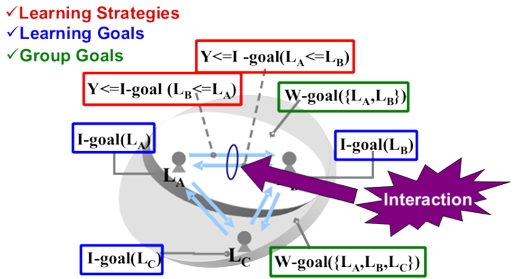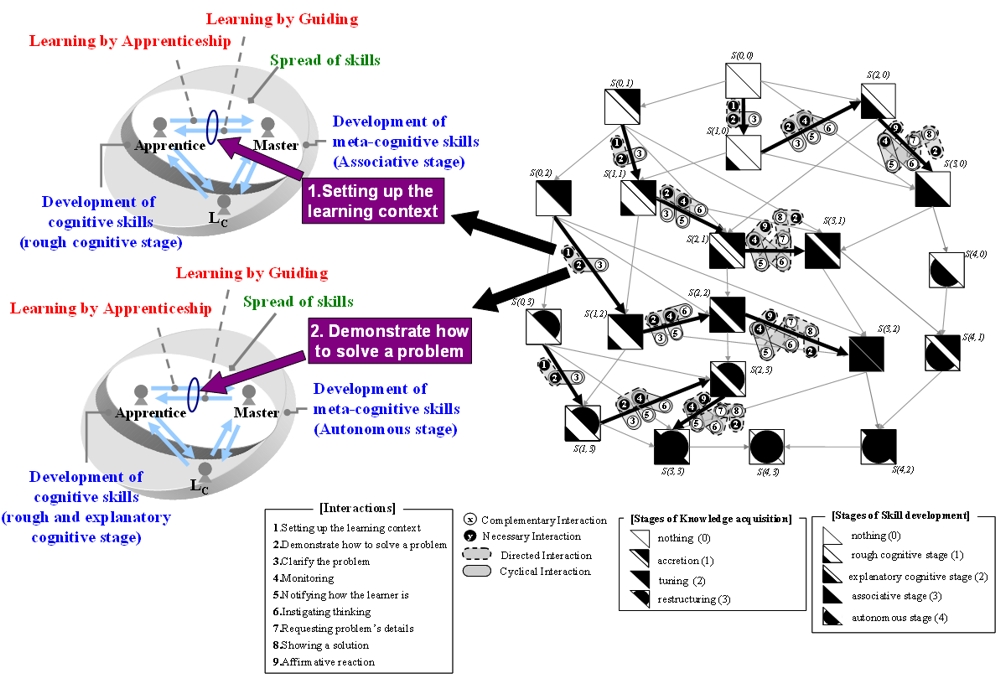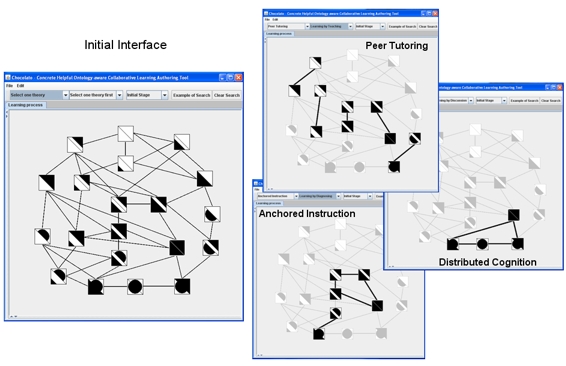
Figure 1. Concepts of Collaborative Learnin Ontology
Towards an Ontology-Aware Authoring System for Collaborative LearningSeiji Isotani |
|
|
Department of Knowledge
Systems Institue of Scientific and Industrial Research I.S.I.R Osaka University, Japan |
isotani 'at' ei.sanken.osaka-u.ac.jp http://www.ei.sanken.osaka-u.ac.jp/~isotani 8-1, Mihogaoka, Ibaraki, Osaka, Japan, 567-0047 Phone: +81-6-6879-8416, FAX: +81-6-6879-2123 |
The CSCL (Computer Supported Collaborative Learning) community has been suffering from a lack of models and tools to support the effective design of collaborative learning (CL) sessions based on learning theories [3]. One reason given by [1;3] is the difficulty of understanding, comparing and using theoretical approaches in real educational applications due to the lack of a common understanding of what a learning theory is. Without such models it is difficult to describe, share and analyze CL processes while making use of learning theories to evaluate educational benefits and to design CL sessions.
Usual approaches provide their systems with a kind of "expertise" using a set of heuristics and domain theories built in the procedures (programming languages). This means that the programmers, not the systems, have an understanding of the knowledge being used. As a result, these systems cannot share or build new knowledge, ignore the existence of theories on which the knowledge is based, and finally cannot justify their recommendations systematically and scientifically [6] . As pointed out by [6]: "neither inference techniques nor beautiful theoretical formalism can contribute to an improvement of the situation".
Our approach calls upon techniques of ontological engineering to, at first, establish a common understanding of what a learning theory is by representing it in terms of its explicitness, formalism, concepts and vocabulary. This makes theories understandable both by computers and humans. We then propose techniques of reasoning on these theories which allows dynamic guiding of instructional planning and an effective design of learning processes.
2. BACKGROUND AND RELATED WORK
In practical terms ontological engineering helps to achieve the following [2;6]:
In CSCL research previous work using ontologies have been successfully applied to solve problems as: group formation [5], interaction analysis [3] and modeling of learner's development [4]. Our approach uses these previous achievements to propose a formalization of learning theory for CL, to create new techniques for effective design and analysis of group learning activities and, finally, to provide foundations for a complete ontology-aware authoring system which can really understand the theories. As part of our work we extend the Collaborative Learning Ontology [5]. Some of the concepts that we use in such ontology are shown in Figure 1.

Figure 1. Concepts of Collaborative Learnin Ontology
3. GOALS OF THE RESEACH AND CURRENT STATUS
Until now, with the achievements of using ontologies in CSCL presented in section 2, it is possible to successfully identify which kind of collaboration occurs in a CL session, understanding the essence of the group's interactions, and to estimate the expected educational benefits for each member. Nevertheless, there are some limitations:
To deal with the problems presented above, we analyze seven different learning theories, frequently used to supported CSCL activities, to clarify the relationships among interaction, learning strategies and learning goals. Thus, based on previous models of interaction processes [3] and learner’s growth [4], we defined an ontological structure to represent an excerpt of the Learning Theory concept. This ontological structure can be represend as a Graph. For example, in Figure 2 we show a graphical visualization of our structure using the learning theory Cogntive Apprenticeship. Each circle in the Figure 2 represents an interaction. For each interaction we have strategies, goals and roles for learners who are interacting.

Figure 2. Graphical example of an ontological structure to
describe the learning theory Cogntive Apprenticeship using
the strategy Learning by Apprenticeship
The proposed structure allows us to work with theories at the macro (strategies and goals) and micro levels (interactions and roles) and to create a link between them. This link clarifies, more precisely, how interactions can affect learner's development helping designers to select interactions and roles for each learner with justifications based on the theories.
4. SOME RESULTS AND CONTRIBUTIONS
The main contribution of our research is to provide an ontological structure to describe learning theories and create techniques to use it rationally [7]. Thus, it becomes the foundation to support the development of ontology-aware authoring systems by solving, at least partially, the problems presented in section 2.Nowaday, we use this structure to describe six learning theories and we have been developing a program to reasoning on these theories to help users to design group activities. Some screeshots of this program are shown in Figure 3.

Figure 3. Screeshots of one of the sub-systems developed
to support the desgin of CL activities using learning theories.
The possibility of clarifying what a CL session is and to amplify its educational benefits has been a great challenge. In this context our approach offers a declarative representation of learning theories allowing computational support for analysis and designing of CL sessions in compliance with theoretical procedures and, because it can be explicitly demonstrated, is much more convincing and flexible than usual approaches.
6 REFERENCES
1. Conole, G., Dyke, M., Oliver, M. and Seale, J. (2004) "Mapping
pedagogy and tools for effective learning design". Computer & Education,
43, 1-2, 17-33.
2. Devedzic, V. Understanding Ontological Engineering. Communications
of the ACM, 45, 4, (April 2002), 136-144.
3. Inaba, A., Ohkubo, R., Ikeda, M. and Mizoguchi, R. Models
and Vocabulary to Represent Learner-to-Learner Interaction Process in Collaborative
Learning. In Proceeding of the Int. Conference on Computers in Education, 1088-1096.
4. Inaba, A., Ikeda, M. and Mizoguchi, R. (2003b) What Learning
Patterns are Effective for a Learner’s Growth?. In Proceeding of the Int. Conference
on Artificial Intelligence in Education, 219-226.
5. Inaba, A., Supnithi, T., Ikeda, M., Mizoguchi, R. and Toyoda,
(2000) J. How Can We Form Effective Collaborative Learning Groups?. In Lecture
Notes in Computer Science 1839, 282-291.
6. Mizoguchi, R. & Bourdeau, J. (2000) "Using Ontological
Engineering to Overcome AI-ED Problems", Int. Journal of Artificial Intelligence
in Education, 11, 2, 107-121.
7. Isotani, S. & Mizoguchi, R. (2006) "A Framework
for Fine-Grained Analisys and Design of Group Learning Activities", In
Proceeding of the Int. Conference on Computers in Education, 193-200.